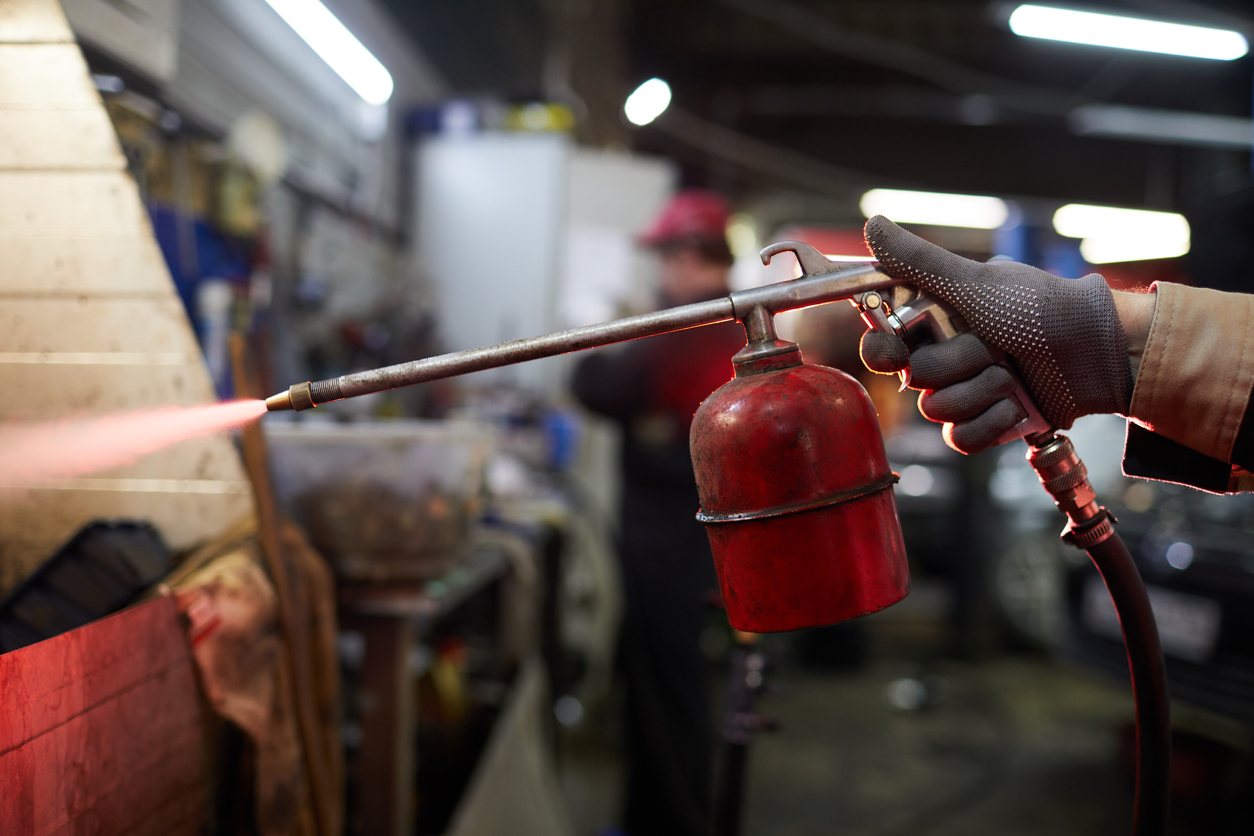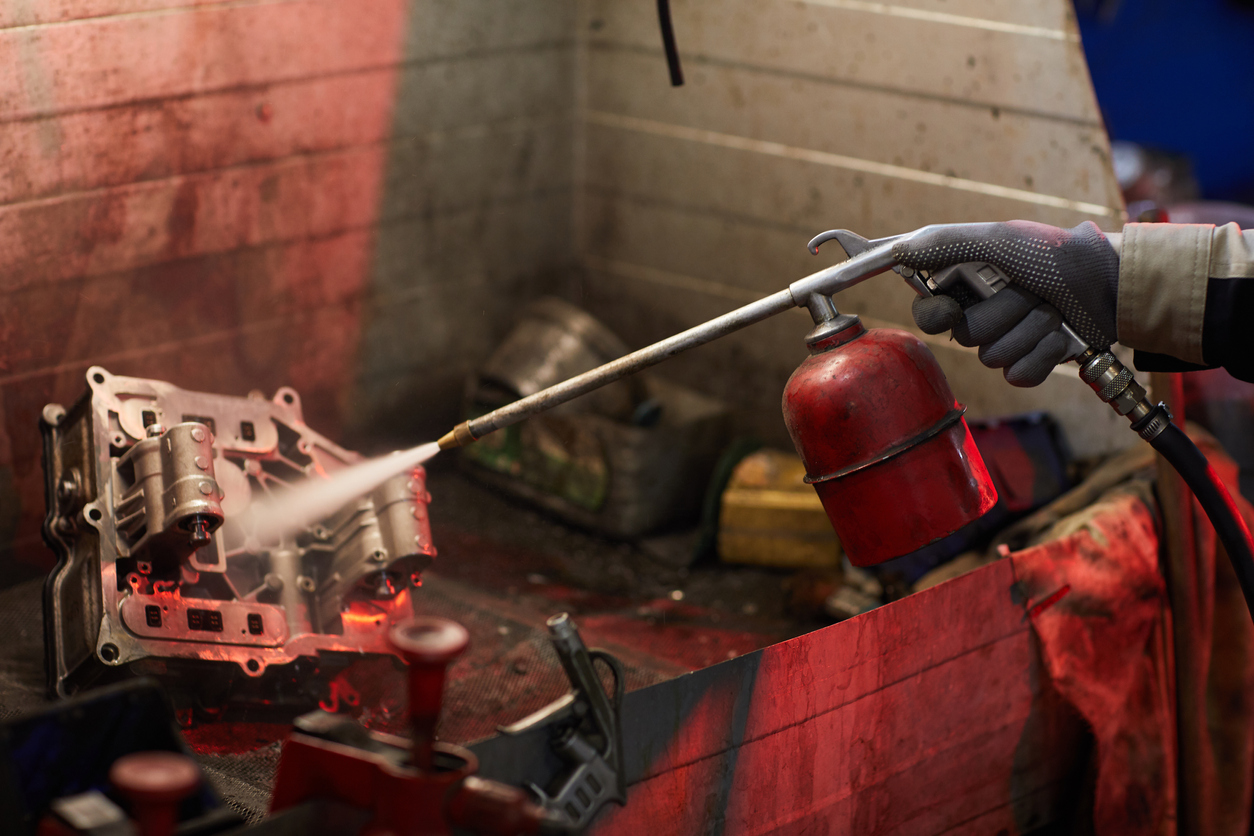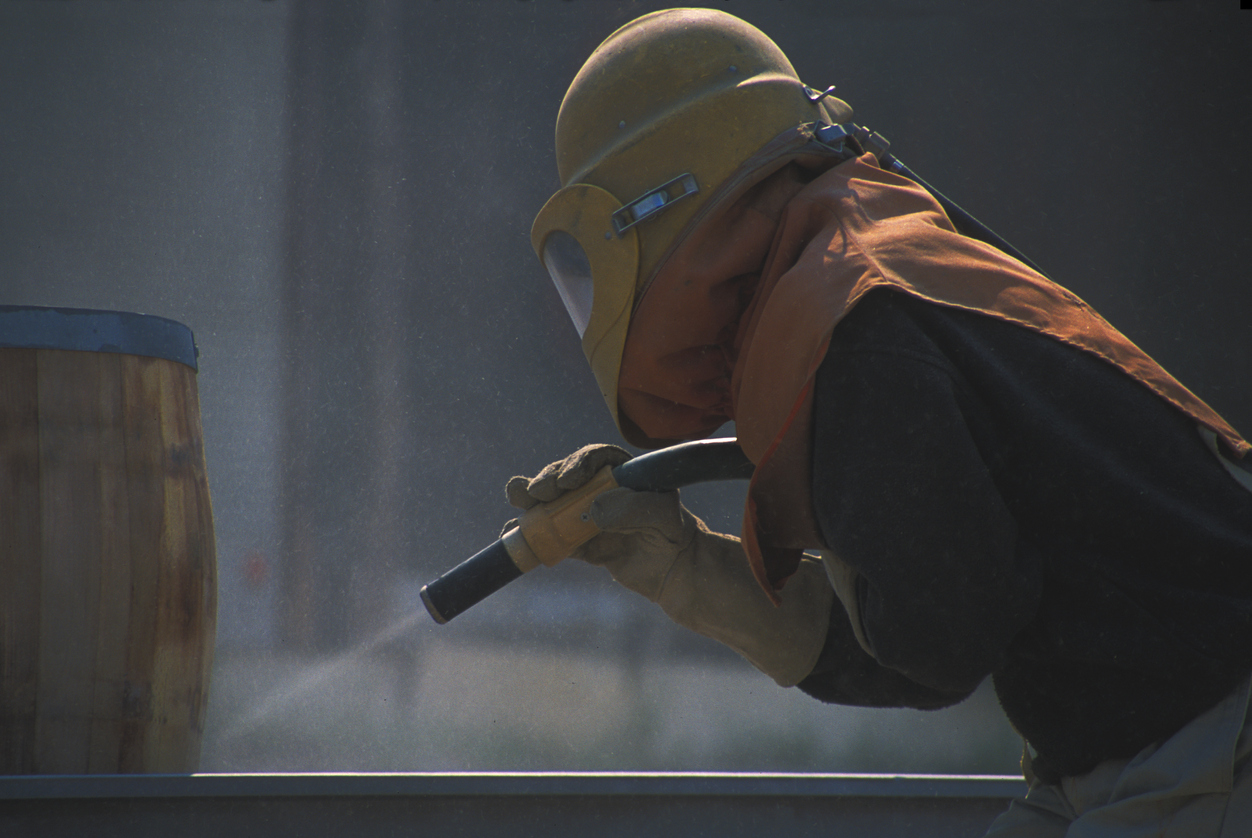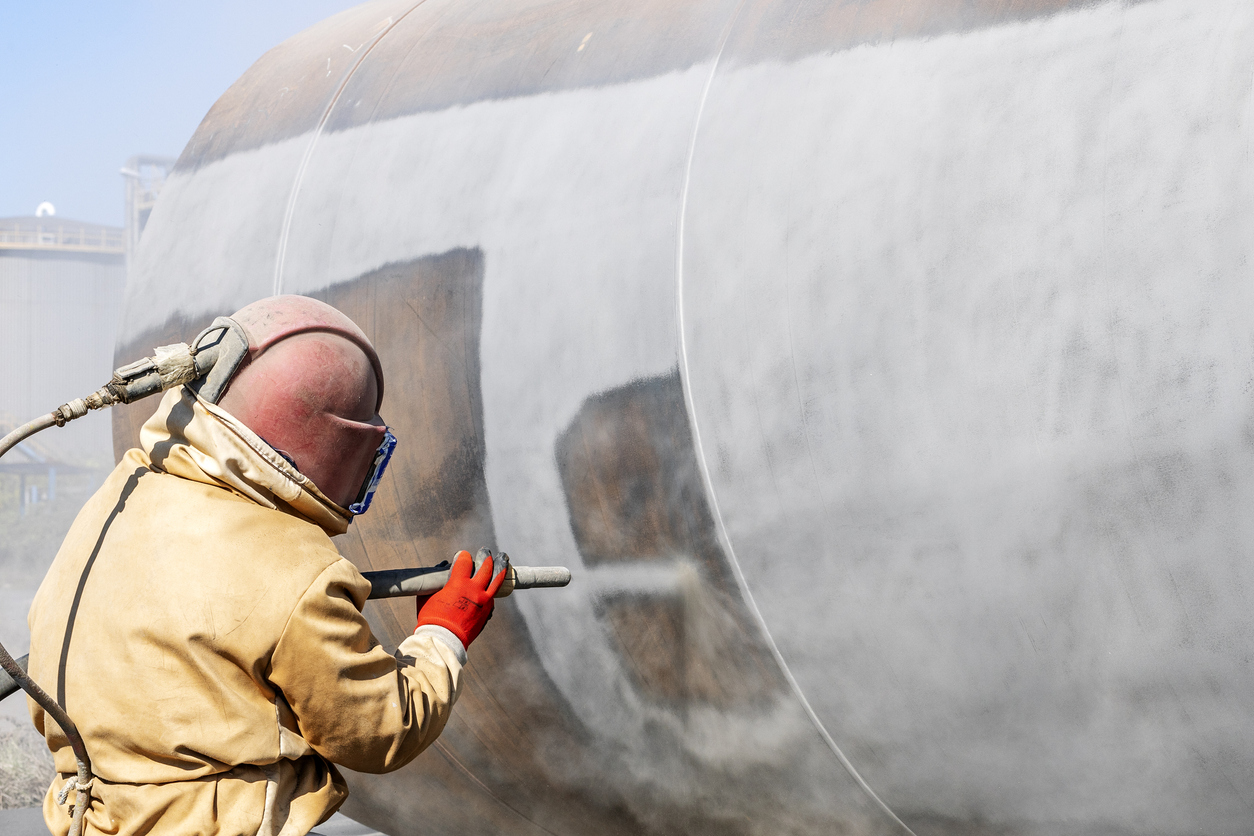

We may earn revenue from the products available on this page and participate in affiliate programs. Learn More ›
Highlights
- The answer to how much sandblasting costs is about $1,000 on average, though a typical range is $437 to $1,656.
- Sandblasting costs are largely dependent on key factors such as the size of the surface, the medium (material) used, the optimal method, current labor rates, and additional customizations that may apply.
- Many people opt to sandblast small items, exteriors of homes, decks, or fences to remove rust, adhesive, dirt, or other contaminants in a faster and more environmentally friendly method than the use of harsh chemicals.
- Experienced DIYers working on small projects may choose to use small sandblasters, but there are protocols that professional sandblasters will follow to reduce personal injury and damage to larger surfaces.
Sandblasting is the process of cleaning, stripping, or preparing a surface by propelling abrasive materials at a high velocity to remove the exterior layer of paint, rust, wax, or dirt. It helps achieve a clean, smooth finish on old furniture, homes, decks, concrete driveways, and many other surfaces. How much does sandblasting cost? The cost of sandblasting varies depending on the size of the surface area, the type of medium used, the method, and any add-ons a homeowner requests. According to HomeAdvisor, the cost of sandblasting ranges from $437 to $1,656, with many homeowners spending $1,000. It typically costs from $1 to $5 per square foot, but the overall cost will vary depending on the size of the surface area.
The most common sandblasting methods include wet, dry, and dustless sandblasting; hydro blasting; and dry ice blasting. Each type has its own benefits and price ranges, and some are more environmentally friendly than others. Local labor prices also influence how much a sandblasting service charges. The average cost of labor runs from $45 to $75 per hour, or $1.50 to $3 per square foot.
Before using one of the best power tool sets to tackle a heavy-duty cleaning problem, homeowners are advised to consider the specific requirements for their project and consult with professionals to get accurate sandblasting prices. Whether a homeowner needs help sandblasting wood or they need a sandblasting kit for a small project, understanding what factors go into sandblasting cost can help them make an informed decision and budget successfully for their project.
Factors in Calculating Sandblasting Cost
When homeowners are calculating sandblasting costs, several important factors come into play, such as the surface area, surface type, sandblasting method and intensity, medium (or material) type, local labor pricing, customizations, and add-ons. Taking all these elements into consideration can help homeowners calculate a more accurate pricing estimate when they start budgeting for a sandblasting project.

Surface Area
The size of the surface area is one of the most significant aspects for calculating the cost of sandblasting. Larger surfaces require more time, effort, and media, all of which contributes to an increase in price. A complex surface with intricate details like a wrought-iron fence may also require additional time, leading to a higher cost, while smaller surfaces may have a lower cost due to the reduced scale of the project.
When homeowners are dealing with an extremely large area such as a home or driveway, they may need an industrial-size sandblasting machine. It’s important for homeowners to note that despite the higher costs associated with sandblasting larger surface areas, choosing professional sandblasting services typically remains a more cost-effective option than alternative methods.
Surface Type
Whether it’s removing old paint from wooden surfaces or rust from metal structures, or restoring concrete walls, sandblasting projects can vary in cost depending on the type of surface being treated. For instance, sandblasting a wooden deck takes more time and materials than sandblasting an old metal stool. It can cost from $1.50 to $8 per square foot to sandblast different types of surfaces.
| Surface Type | Average Cost (Materials and Labor) |
| Brick | $2.50 to $3 |
| Concrete | $2.50 to $3.50 |
| Stucco | $1.50 to $3.50 |
| Tile | $1.50 to $3 |
| Wood | $2 to $3 |
| Wrought iron | $4 to $8 |
- Brick surfaces. Professional sandblasters know how to remove paint from brick without damaging it. This process helps to get rid of dirt and grime to restore the original appearance of the brick. It typically costs from $2.50 to $3 per square foot to sandblast a brick surface.
- Concrete surfaces. Concrete can be cleaned and prepared for new sealant or coloring with sandblasting. The cost to sandblast concrete runs from $2.50 to $3.50 per square foot. Newer concrete surfaces may require less time and effort, while older or damaged surfaces may need more time and attention to detail, which can increase the overall cost. Knowing how to remove paint from concrete is important for a homeowner or sandblasting pro so that damage to the concrete can be avoided.
- Stucco surfaces. Stucco is usually sandblasted to prepare the surface for repairs or painting. Since stucco is softer than dried paint, additional care needs to be taken with the sandblasting pressure and medium to ensure the stucco is not damaged. Homeowners can expect to pay from $1.50 to $3.50 per square foot to sandblast this surface.
- Tile surfaces. Depending on the type of tile and the sandblasting medium, sandblasting tile can cost between $1.50 and $3 per square foot. This involves a time-consuming process to make sure the tiles aren’t damaged while they’re being cleaned, stripped of paint, or prepared for repairs.
- Wood surfaces. Since wood is a softer material, it needs a more delicate approach during sandblasting. A soft abrasive, such as crushed glass or baking soda, is commonly used on wood surfaces to avoid damaging the material. Extensive care and expertise are needed to prevent any excessive blasting or surface damage, and these may increase the overall cost of labor. Sandblasting wood can cost from $2 to $3 per square foot.
- Wrought-iron surfaces. Wrought iron can be sandblasted for $4 to $8 per square foot. Since many wrought-iron surfaces have complex and intricate details, the sandblasting process is a more complicated job, which results in higher costs.
Sandblasting Method and Intensity
The overall cost of sandblasting ranges from $1 to $5 per square foot, depending on the method. Various types of surfaces and locations require a specific type of sandblasting, which will impact the overall cost of the project. The intensity of the sandblasting determines the strength and speed at which the abrasive medium is blown onto the surfaceHigher-intensity sandblasting methods will clean and strip a surface faster, but they also require more aggressive techniques. Lower-intensity sandblasting methods are more suitable for delicate surfaces, such as stucco, as these can damage easily. The most common types of sandblasting methods include dry, dry ice, dustless, wet, and hydro blasting. They use different types of media and work better for certain surfaces rather than others.
Media Types
The surface that needs to be sandblasted will dictate what kinds of media, or materials, can be used. For surfaces that need a more delicate approach, silica and corn cobs are budget-friendly options to avoid damaging the surface. More expensive media options include silicon carbide and copper slag, which can cost up to $5 per pound. Knowing how the media types influence the overall cost of sandblasting can help homeowners understand how much sandblasting costs.
| Sandblasting Media Type | Average Cost per Pound (Materials Only) |
| Acrylic | $4 to $4.50 |
| Aluminum oxide | $2 to $2.50 |
| Copper slag | $4 to $5 |
| Corn cobs | $0.80 to $1 |
| Glass beads | $1.50 to $2.50 |
| Pumice | $2.50 to $3.50 |
| Silica | $1.50 to $1.80 |
| Silicon carbide | $4 to $4.50 |
| Soda | $1.50 to $2.50 |
| Steel grit | $2 to $2.50 |
| Walnut hulls | $2 to $3 |
- Acrylic. Also known as plastic abrasive grit, acrylic sandblasting media costs from $4 to $4.50 per pound. As a less aggressive sandblasting material, it’s used on delicate and soft surfaces to remove wax, mold, adhesives, sealants, and anti-corrosion coatings.
- Aluminum oxide. Used mostly to clean marble, granite, glass, and steel, aluminum oxide ranges from $2 to $2.50 per pound. Since it’s a strong and abrasive medium, using it on soft, delicate surfaces is not recommended.
- Copper slag. Commonly used to sandblast masonry, copper slag costs between $4 and $5 per pound. Copper slag is a byproduct of copper extraction and contains heavy metals that can be hazardous. As a result, some sandblasting professionals do not use it in their blasting process. Still, it’s highly effective and produces low levels of dust, which many professionals view as a benefit.
- Corn cobs. As one of the most budget-friendly sandblasting media options, corn cobs cost from $0.80 to $1 per pound for sandblasting. Crushed corn cobs are an environmentally friendly option and are preferred for cleaning delicate surfaces without causing damage. The media grit size varies from extra fine to extra coarse, and it’s a common material for stripping or cleaning wood. Since the process of using corn cobs for blasting is labor intensive, using this sandblasting material can cost more than $2 per square foot.
- Glass beads. Glass beads cost from $1.50 to $2.50 per pound. Since they don’t contain free silica or lead, they are another environmentally friendly option. Used primarily for cleaning surface edges and burring, glass bead blasting gives surfaces a smooth finish.
- Pumice. This mild abrasive with a spongelike density ranges in price from $2.50 to $3.50 per pound for sandblasting. It’s recommended for less aggressive cleaning to remove scale, rust, and various coatings on metal, plastic, and wood surfaces.
- Silica. Silica blasting media costs from $1.50 to $1.80 per pound. Consisting of gravel and sand with silicon dioxide compounds, silica is hazardous to breathe and can cause respiratory issues and environmental damage. Even though it’s commonly used due to its low price, some countries have banned the use of silica as a blasting medium because of the health and environmental problems it causes.
- Silicon carbide. Reusable silicon carbide is an eco-friendly sandblasting material that runs from $4 to $4.50 per pound. It’s the hardest blasting material and is often used for difficult stripping or cleaning projects.
- Soda. Soda is commonly used to blast delicate surfaces at a cost between $1.50 and $2.50 per pound. As one of the oldest blasting materials, soda can cost from $45 to $75 per hour for sandblasting jobs.
- Steel grit. Used for heavy-duty blasting projects, steel grit costs from $2 to $2.50 per pound. This recyclable material is typically recommended for stripping and cleaning metal surfaces.
- Walnut hulls. Crushed walnut shells are another environmentally friendly blasting media option. At a cost between $2 and $3 per pound, walnut shells are considered a soft abrasive that can be used on surfaces that can’t tolerate additional pressure, such as plastic, wood, soft metals, some stones, and fiberglass.
Labor
Homeowners can expect to pay between $45 and $75 per hour for sandblasting services, or $1.50 to $3 per square foot. Labor doesn’t include just the sandblasting process; it also involves the preparation and cleanup that go into the service. It’s common for sandblasting technicians to cover and protect the surrounding area within 30 feet of the blasting location when working on a homeowner’s property. This can include taping windows and laying down tarps to protect other surfaces such as landscaping or walls. Once the sandblasting process is complete, the media is usually vacuumed up for reuse or washed away.

Customizations and Add-Ons
It’s common for some homeowners to add on to their sandblasting project with customizations or other sandblasting projects. These can include sandblasting a car and wheel rims, sandblasting a cast-iron tub, blasting a driveway surface, adding rust inhibitor paint, or sandblasting a backyard pool.
- Sandblasting a car. The cost to sandblast a car ranges from $550 to $750 when plastic media is used, but the cost increases to $800 to $1,100 when glass beads are used. The price range typically includes the underside, inside, and outside of the car, but wheel rims may not be included in the estimate.
- Sandblasting car rims. The price to sandblast car rims runs from $20 to $70 per wheel, depending on the wheel size, number of rims, and the type of blasting media. It’s common to sandblast car rims to remove dirt, grime, and corrosion or to remove paint.
- Sandblasting a cast-iron tub. Bathtub refinishing costs typically include the sandblasting process in the price estimate to refinish and re-enamel the entire cast-iron surface. The overall refinishing price ranges from $335 to $628.
- Sandblasting a driveway. Sandblasting a driveway ranges in cost from $2 to $5 per square foot. Since driveways can be damaged from debris and car fluids, sandblasting the surface can remove contaminants from the surface and revive the driveway surface.
- Adding rust inhibitor paint. After a metal surface is sandblasted, it’s common to add a layer of rust inhibitor paint, especially if the surface was blasted with wet abrasives. At a cost of $200 to $250 per 5-gallon bucket, rust inhibitor paint provides a protective barrier that prevents rust from forming on the surface.
- Sandblasting a swimming pool. Since swimming pools can show signs of wear and tear after years of use, sandblasting the surface can restore the pool by removing flaking or peeling paint. Homeowners can expect to pay from $1 to $2 per square foot for pool sandblasting.
Sandblasting Methods and Types
The overall cost of a sandblasting project also depends on the type of sandblasting method. If a homeowner has questions about the best sandblasting method for their home and property, a professional can provide recommendations based on the surface material and the desired outcome of the project. For example, sandblasting the inside of a home requires different methods than sandblasting wheel rims or the outside of home. Knowing how these techniques and methods influence the cost of sandblasting services can provide insight into the pricing and sandblasting process.
| Sandblasting Method | Average Cost per Square Foot (Materials and Labor) |
| Dry sandblasting | $2 to $4.50 |
| Dry ice sandblasting | $3.50 to $5 |
| Dustless sandblasting | $2 to $3 |
| Hydro blasting | $1 to $2.50 |
| Wet sandblasting | $1.30 to $3.50 |
Dry Sandblasting
Dry sandblasting costs from $2 to $4.50 per square foot. Since dry sandblasting takes longer and requires the technicians to wear personal protective equipment, the cost is a bit more than for wet sandblasting. Dry blasting is commonly used on corrosive surfaces, since it avoids the formation of rust.
Dry Ice Sandblasting
Dry ice blasting ranges from $3.50 to $5 per square foot. This method involves propelling carbon dioxide (CO2) in its solid form of dry ice to strip and clean a surface. When the dry ice pellets hit the surface, extreme heat is released, which dissolves anything on the surface. Professional sandblasters must ensure there is proper ventilation when this method is used indoors, since it can cause deadly CO2 poisoning.
Dustless Sandblasting
Dustless sandblasting costs between $2 and $3 per square foot. To avoid letting dust particles fly everywhere, professionals often combine various types of blasting media with water. This technique is commonly used to sandblast car parts, with an entire car exterior priced at around $1,000 and wheels at $40 each.
Hydro Blasting
Hydro blasting costs from $1 to $2.50 per square foot. There are no abrasive blasting materials involved when homeowners are using a pressure washer sandblaster—just high-pressure water. This is a commonly used technique to clean delicate surfaces that need a gentle method.
Wet Sandblasting
Homeowners can expect to pay from $1.30 to $3.50 per square foot for wet sandblasting. This technique uses wet sand to clean a surface. The process takes less time than dry sandblasting, saving on labor costs. Homeowners are advised to apply a rust inhibitor after using wet sandblasting on corrosive surfaces.

Benefits of Sandblasting
Sandblasting can smooth a rough surface or remove contaminants, such as dirt, rust, or paint. Some benefits of sandblasting include rust removal, environmental safety, and proven effectiveness at restoring a surface to its original quality.
Rust Removal
Rust is the dreaded enemy of any metal surface. Whether it’s on an old car, machinery, or even a piece of furniture, rust can cause serious damage and deterioration over time. Knowing how to remove rust can help homeowners extend the life of useful items, and sandblasting stands out as one of the most effective ways to do so.
Sandblasting is a popular choice since it can break down rust and reveal a smooth and clean surface underneath. The process is an excellent solution to easily restore contaminated, hard-to-reach areas or complex surfaces more thoroughly than attempting to update by hand.
Environmental Safety
While the main purpose of sandblasting is to clean or prepare surfaces for refinishing, it also offers a range of environmental benefits by contributing to environmental safety. One of the biggest advantages of sandblasting is that it eliminates the need for harsh chemicals during the resurfacing process. By using high-pressured air or water to propel abrasive materials when homeowners are cleaning or stripping a surface, sandblasting significantly reduces the use of harmful chemicals and pollutants in the environment. When natural materials are used in the sandblasting process, they can often be recycled or reused.
Effectiveness
One of the main factors behind the effectiveness of sandblasting is the sheer power of the process. By forcefully propelling a stream of abrasive media at a surface, sandblasting can remove various types of unwanted materials, such as rust, dirt, grime, and paint. The versatility of the process also contributes to its effectiveness. It can be used on a wide range of materials, such as wood, metal, brick, concrete, and more delicate surfaces such as glass.
The ability to effectively clean different surfaces with just one method saves time and effort. Compared to other cleaning and stripping methods that require more physical labor and time, sandblasting is typically less labor-intensive.

Sandblasting: DIY vs. Hiring a Professional
An advantage of using one of the best sandblasters for homeowners wanting to tackle a sandblasting project on their own is the potential savings on labor costs. Using a small sandblaster or sandblasting cabinet for minor projects can be something an experienced DIYer can do, but it’s important to understand how difficult sandblasting can be for large tasks. Improper technique or use of the wrong media can result in surface damage, uneven results, and even personal injury.
Perhaps most importantly, sandblasting can be hazardous, and without the proper knowledge, tools, equipment, and protective gear, there can be significant risks. Those who are inexperienced with sandblasting are advised to hire a professional to ensure the job is done safely and effectively. Professional sandblasting companies are experienced at safely handling the various materials and preparing the area in a way that prevents damage and safety risks during the process. And in many cases, professionals have dedicated workplaces to safely sandblast smaller items (such as table legs, wheel rims, or chairs) without inconveniencing a homeowner.
How to Save Money on Sandblasting Cost
Sandblasting is an excellent way to strip and clean a surface of rust, dirt, wax, adhesives, limescale, and paint. With a bit of research and planning, homeowners can save money on the sandblasting process.
- Get multiple estimates. It’s recommended that homeowners get at least three estimates from reputable sandblasting companies in their area to find a price that works with their budget.
- DIY small projects. Renting a portable sandblaster or using a small handheld sandblaster for minor projects can be a cost-effective way for experienced homeowners to avoid paying for a sandblasting service.
- Choose the correct abrasive media. While it may be tempting to pick the cheapest blasting media to save money, choosing the right material for the job will help homeowners complete the project in a timely manner and avoid spending more money if the process needs to be repeated.
- Bundle sandblasting projects. If a homeowner has multiple items that need to be sandblasted, it’s recommended they complete all of them at the same time. Sandblasting companies often offer discounts for multiple projects.
- Do some of the prep work yourself. Before the professionals arrive, homeowners can take the time to prep the area by clearing the space, covering items and areas that need to be protected, and providing easy access for the sandblasting equipment.
- Reuse media. By selecting pre-used media, homeowners can save significantly on sandblasting costs.
Questions to Ask About Sandblasting
Asking a sandblasting specialist the right questions can help homeowners save money, avoid miscommunication, and gain a better understanding of the sandblasting process.
- What is your experience in sandblasting?
- Can you provide references or examples of similar sandblasting projects you’ve completed?
- Do you have a detailed breakdown of the cost estimate?
- What is your pricing structure?
- Are there any potential additional charges?
- What type of abrasive media will you use for the job?
- What safety precautions will you follow to protect the surrounding area, the workers, and the environment?
- What sandblasting method do you recommend?
- What equipment will you use?
- How long will the sandblasting process take?
- Do you need to complete any surface repairs?
- Is there any way I can help prepare the surface by cleaning?
- Do you offer any warranties or guarantees?
- What is the expected lifespan of the treatment?
- How will you handle the cleanup and disposal of waste materials?
- What types of maintenance are required after the sandblasting process?
- What is your payment plan?
- How can I leave a review of your services?
FAQs
Many homeowners who are considering hiring a sandblasting service are often unsure of the cost and the overall sandblasting process. They can use these answers to some frequently asked questions about the sandblasting process, the disadvantages of sandblasting, and the timing of painting after sandblasting. Understanding these aspects can help homeowners understand how much sandblasting costs.
Q. Does sandblasting leave a smooth surface?
Yes. Sandblasting leaves a smooth surface that acts as a good preparation for restoration or painting.
Q. What are the disadvantages of sandblasting?
Depending on the type of abrasive media, sandblasting can be hazardous to the environment and require specialized handling for disposal of the material. It can also be harmful to the sandblasting technician as well. Adequate personal protection equipment is needed to prevent health risks, which can include lung disease and choking hazards.
Q. Can you paint directly after sandblasting?
Many professionals recommend applying paint or an additional coating to the sandblasted surface no more than four hours after completing the blasting project.
Sources: HomeAdvisor, Fixr
